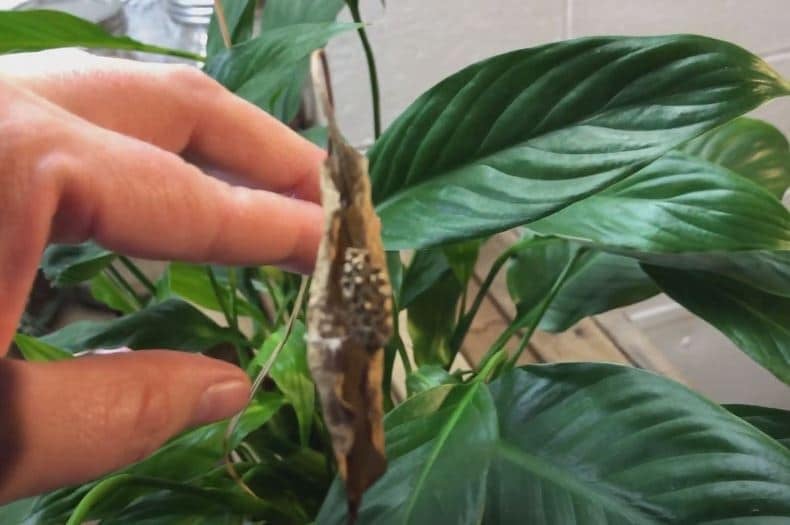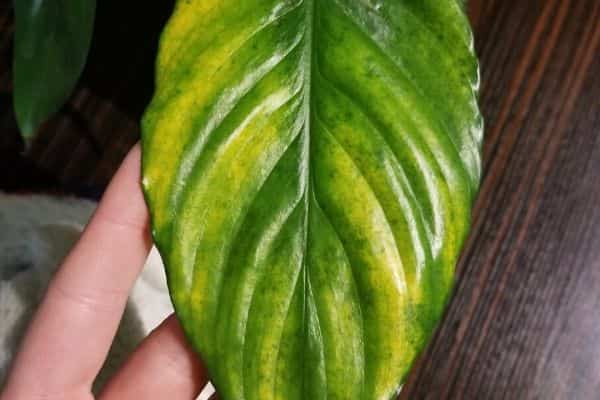Peace Lily Pruning: When + How to Cut Back
Pruning peace lilies helps prevent pests and disease and removes old, yellowing foliage to keep the plant fresh with green foliage. Each stalk of a peace lily plant blooms only once, so cutting it back allows the plant to remain healthy and bloom frequently.
So, how do you prune a peace lily?
To prune a peace lily, cut off old stalks that have already flowered right at the base because they will not flower again. Also, remove the outer leaves that are old and yellowing from each plant in the pot while leaving the center growth to thrive. This will help prevent pests and diseases.

As the bloom duration nears and ends (usually about a month after the appearance of the spadix flower and spathe), the spathe – which is actually a modified leaf – reverts to a green color, wilts, and dies.
To help the peace lily plant bloom again, prune off the wilted bloom, as well as the accompanying stalk using a sharp hand shear for pruning (I use and recommend this Felco Classic Manual Hand Pruner)
I’ll guide you on how to prune your peace lily and explain why and when peace lilies need to be pruned.
Do peace lilies need to be pruned?
Peace lilies should be pruned to help them bloom more and remain healthy and bushy with green foliage. Cutting back your peace lily helps prevent diseases and pests such as mealy bugs and yellowing.
Once the blossoms of your peace lilies wilt/fade, they need to be pruned. This pruning is only targeted at the spent spadix flowers and accompanying drooping spathes – and is referred to as deadhead pruning.
While deadhead pruning is usually enough to facilitate re-blooming in other houseplant species such as sage and Shasta daisy, it won’t help your peace lilies re-bloom. Instead, deadheading your peace lilies only serves an aesthetic purpose.
Pro tip: To get your peace lilies to bloom again after the blossoms fade, prune off the affected blossoms and the accompanying stalk/stem. Typically, a peace lily stalk produces just a single spadix flower/spathe, just once. After the bloom fades, the stalk that produced it gradually turns brown and dies off.
This is why deadhead pruning alone, without pruning the accompanying stalk, is ineffective if you’re looking to get your peace lilies to bloom again.
How to prune a peace lily
The method of pruning your peace lily will depend on whether you’re pruning to facilitate re-bloom, or whether you’re pruning to get rid of spent flowers and restore the plant’s appearance.
For general care, here’s how to prune a peace lily:
- Locate the base of the stem of the dead blossom.
- Cut off the stalk as close to the base as possible.
- Repeat the above step for all stalks with wilting blooms.
- Cut back all the outer leaves that are old and yellowing.
This pruning process will leave your peace lily healthy and greener – ready to bloom again.
For deadhead pruning only, do the following:
- Pinch the flower stalk just beneath the base of the dead flower.
- Repeat for all spent blooms on all your peace lily houseplants.
If you have too many peace lilies and deadhead pruning by pinching seems too slow, a faster method to deadhead the spent blooms is to shear away the top half of each peace lily. This would effectively get rid of the faded blossoms.
However, when using this method, avoid pruning off thriving peace lily blooms that the faded ones may conceal.
When should I cut back my peace lily?
Prune your indoor peace lilies when the blooms fade and wilt or if the plants have overgrown and are taking up too much space. Pruning off dead flowers and leaves helps reduce the space the plants take up. You can also cut back the plant when the old foliage is yellowing and wilting.
Ideally, you should wait for the peace lily bloom (spadix flower and spathe) to die out before you can proceed to prune it and the accompanying stem off the plant. This usually takes about a month after the appearance of the blossom.
Flower and stem pruning can be undertaken even while your foliage is still green; you don’t have to wait for the peace lily’s leaves to start wilting.
Note that deadhead pruning by pinching should typically commence around late spring when only a few blossoms have faded.
I recommend pruning whenever you see dead blooms, stems, and dead or yellowing/browning leaves.
Leaf yellowing or browning in peace lilies is almost always moisture related. Excessive watering or insufficient moisture can cause peace lily leaves to turn brown or yellow from their characteristic dark green shade.
Whenever you notice leaf browning on your Spathiphyllum, you should prune/cut back the affected foliage for aesthetical purposes (brown/yellow leaves ten o be unsightly).
Can you completely cut back a peace lily?
You can completely cut back a peace lily if all its foliage is damaged. However, leaving some foliage to help the plant regrow and turn green again is a good idea.
Should I cut brown and yellow leaves off a peace lily?
Yes. While pruning off yellow/brown leaves off your peace lily won’t solve the underlying issue (yellowing is most often caused by excess water or minerals in the soil o which your peace lilies grow), it’ll help restore the houseplant’s aesthetic appeal.
Moreover, leaf tip pruning helps save the remaining leaf from turning brown, starting at the leaf tips.
Here’s how to cut off brown and yellow leaf tips:
- Use a pair of shears to prune off the brown leaf tip on a single affected leaf. This should be done at an angle.
- Repeat the above step for all leaves with browning leaf tips.
- If the damage goes beyond a leaf tip to the rest of the leaf, clip off the entire leaf at the intersection of its petiole and the plant base, much like you would prune browning stems.







